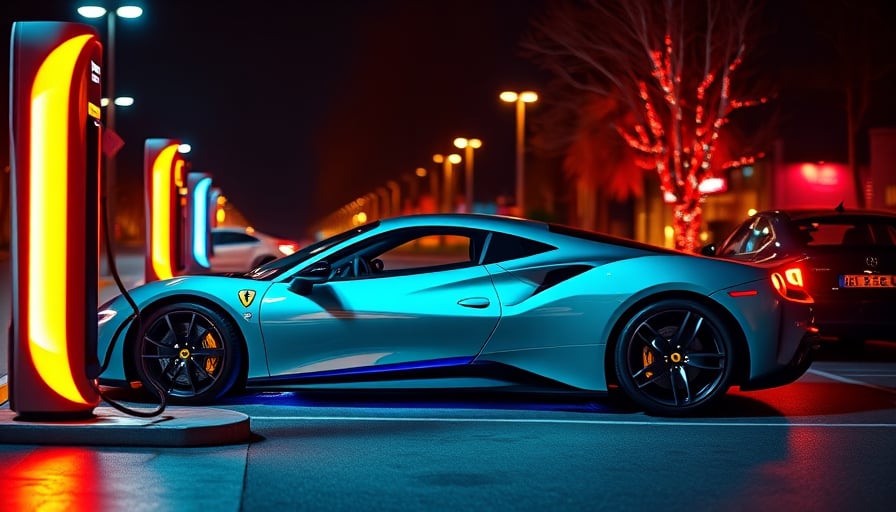Ferrari NV Faces Share Decline Amid Strategic Adjustments
Ferrari NV’s shares have fallen by 21 % over the last five trading days, a sharp downturn that analysts attribute to the company’s recent announcement of scaled‑back growth projections. The reduction in forecasted earnings has raised concerns among investors who had expected continued expansion of the luxury automobile brand’s high‑margin product portfolio.
Impact of Revised Growth Projections
The revised growth outlook signals a shift in Ferrari’s strategic priorities. By trimming growth targets, the company appears to be prioritizing short‑term financial discipline over long‑term expansion. This move may have been prompted by broader market volatility and heightened scrutiny of premium vehicle sales in the wake of tightening regulatory standards for emissions and safety.
From a financial standpoint, lower projections reduce the expected earnings per share (EPS) trajectory, thereby compressing the price‑to‑earnings (P/E) ratio that equity markets typically use to value high‑growth automakers. Consequently, the market has repriced Ferrari’s equity at a lower multiple, contributing to the observed share price decline.
Introduction of the Elettrica Electric Vehicle
In a bid to counteract the dip in investor confidence, Ferrari has announced the launch of its first electric vehicle, the Elettrica. The new model represents a strategic pivot toward electrification, aligning the brand with the industry’s shift toward low‑emission powertrains. This development is particularly significant for a manufacturer traditionally associated with high‑performance gasoline engines.
- Competitive Positioning: By entering the electric segment, Ferrari aims to compete with emerging players such as Lucid Motors and established automakers like Porsche, both of which have announced electric supercars in recent years. The Elettrica’s performance specifications—accelerating from 0 to 100 km/h in under 3 seconds—will allow Ferrari to retain its performance reputation while expanding its customer base to include environmentally conscious consumers.
- Market Drivers: Government incentives for electric vehicles, coupled with stricter emissions regulations, are accelerating demand for plug‑in models. Ferrari’s entry into this segment positions it to capture a share of the premium EV market, which is projected to grow at a CAGR of 30 % over the next decade.
- Fundamental Principles: The move demonstrates an adherence to the principle of product diversification. By broadening its portfolio beyond internal combustion engines, Ferrari mitigates reliance on a single revenue stream and strengthens its resilience to macroeconomic shifts.
Sustainability Initiatives and Circular Economy Efforts
Ferrari’s focus on sustainability extends beyond electrification. The company recently obtained a certificate under the SEBI (Depositories and Participants) Regulations, 2018. This certification confirms Ferrari’s commitment to reducing its environmental footprint through robust recycling and circular economy practices.
Key aspects of this initiative include:
- Material Reclamation: Implementation of advanced recycling processes for aluminum, carbon fiber composites, and other high‑value materials used in vehicle construction.
- Supply Chain Transparency: Adoption of traceability systems to ensure that all components are sourced from suppliers who comply with environmental standards.
- Carbon Reduction Targets: Setting measurable reductions in greenhouse gas (GHG) emissions across the entire value chain, from manufacturing to end‑of‑life disposal.
These efforts are not only aligned with global sustainability mandates but also enhance brand equity among environmentally conscious consumers. Moreover, by embracing a circular economy model, Ferrari can reduce raw material costs, thereby improving operational margins.
Broader Economic Context
Ferrari’s recent strategic shifts illustrate a broader trend among luxury automakers, who are increasingly balancing performance with sustainability. The company’s moves reflect several macroeconomic dynamics:
- Regulatory Pressure: Stringent emission standards in Europe and the United States are driving automakers toward electrification and cleaner manufacturing processes.
- Consumer Preference Shifts: Millennials and Gen Z buyers demonstrate a growing preference for eco‑friendly products, even within the high‑end segment.
- Technological Advancements: Battery technology improvements reduce the cost and increase the performance of electric vehicles, making them more attractive to premium buyers.
In this environment, Ferrari’s ability to adapt—through both product innovation and sustainability commitments—will likely be a decisive factor in its long‑term competitiveness.
Conclusion
Ferrari NV’s recent share price decline underscores the market’s sensitivity to growth expectations. However, the company’s proactive steps toward electrification with the Elettrica and its dedication to circular economy practices signal a strategic recalibration aimed at sustaining long‑term shareholder value. By integrating fundamental business principles with emerging market dynamics, Ferrari is positioning itself to navigate the evolving automotive landscape while maintaining its legacy of performance excellence.
